


xxxxxAs we have seen, Prussia suffered two crushing defeats at the hands of the French at the Battles of Jena and Auerstadt in October 1806. Having knocked the Prussians out of the war, Napoleon then turned on their ally, the Russians. At the Battle of Eylau, fought early in 1807 near the city of Konigsberg in East Prussia, he very nearly met his first major defeat. His attack on the Russian lines was repulsed, and a section of his army was overrun. Only a frontal attack by some 11,000 cavalry saved the day. Loses were heavy, and neither side could claim outright victory. In June, however, a second engagement, centred around the village of Friedland - again near Konigsberg - ended in a stunning victory for the French. The Russian army, having advanced on the village, became encircled beside the River Alle. Some 20,000 were killed by close-range gunfire, or were drowned while trying to make their escape. This outcome forced both Prussia and Russia to accept the terms of the Treaty of Tilsit a few days later.
THE NAPOLEONIC WARS 1803 - 1815 (G3c)
THE BATTLES OF EYLAU AND FRIEDLAND 1807
Acknowledgements
Eylau: by the French painter Antoine-Jean Gros, 1808 – The Louvre, Paris. Tilsit: by the French artist Adolphe Roehn (1780-1867), 1807 – Château de Versailles, France. Maps (Central Europe): from www.clauswitz.co/readings/Bassford. Retreat: by the Bulgarian painter Piotr Stojanow (active 1890-1930). Map (Europe): licensed under Creative Commons – europeanhistoryatloyola.wikipedia.com.
xxxxxAs we have seen, alarmed at the growing power of the French in central Europe following their victories at the Battles of Ulm and Austerlitz, an over-confident King Frederick William III of Prussia declared war against France, and plunged his country straight into battle. Without waiting for the support of his ally, Russia, he sent two armies into Saxony and had them completely routed by Napoleon’s Grand Army at the Battles of Jena and Auerstadt in mid-October 1806. Having totally humiliated the Prussians and occupied Berlin, Napoleon then sought out the Russians (and what was left of the Prussian army) to complete his defeat of the Fourth Coalition. In the New Year he achieved this in the course of two engagements and the Treaty of Tilsit followed within days.
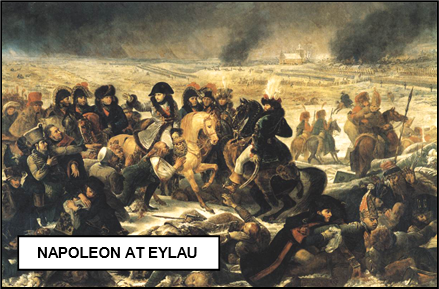 xxxxxThe first of these two engagements, the Battle of Eylau, was fought at the beginning of February 1807 in a blinding snowstorm. Napoleon, intercepting a Russo-Prussian force retreating towards Konigsberg in East Prussia, came very close to his first major defeat. Initially outnumbered, his opening attack against the allied army, drawn up at Eylau, south of the city, was repulsed, and a Russian counterattack overran his 7th corps and put it to flight. In desperation he threw some 11,000 cavalry into a direct assault against three Russian columns advancing for the kill. In one of the greatest cavalry charges in military history they struck through the Russian lines and then, reforming, returned to scatter the Russians across the battlefield. This action saved the day for Napoleon, but casualties were heavy on both sides and neither could claim an outright victory. By nightfall both armies were exhausted and decided to disengage, the Russians and Prussians falling back on Konigsberg.
xxxxxThe first of these two engagements, the Battle of Eylau, was fought at the beginning of February 1807 in a blinding snowstorm. Napoleon, intercepting a Russo-Prussian force retreating towards Konigsberg in East Prussia, came very close to his first major defeat. Initially outnumbered, his opening attack against the allied army, drawn up at Eylau, south of the city, was repulsed, and a Russian counterattack overran his 7th corps and put it to flight. In desperation he threw some 11,000 cavalry into a direct assault against three Russian columns advancing for the kill. In one of the greatest cavalry charges in military history they struck through the Russian lines and then, reforming, returned to scatter the Russians across the battlefield. This action saved the day for Napoleon, but casualties were heavy on both sides and neither could claim an outright victory. By nightfall both armies were exhausted and decided to disengage, the Russians and Prussians falling back on Konigsberg.
xxxxxThe two armies met again four months later, again near Konigsberg, occupied by the Russians and Prussians since the Battle of Eylau. A French corps was sent to occupy the village of Friedland, 26 miles south east of the city, and was suddenly confronted with a Russian force twice its size. In order to take on the garrison, the Russians crossed the Alle River that ran by the village, but the French managed to ward off their attacks for nine hours until reinforcements arrived. Then in the late afternoon Napoleon launched his main attack with some 65,000 men. At first repulsed by a Russian cavalry charge, the French dragoons eventually broke through the enemy’s lines and the Russians, with their backs to the river, suffered enormous losses. Some 20,000 were killed by gunfire, delivered at close range, or were drowned while attempting to cross the river, the bridges having been destroyed. The next day the Prussian force, some 25,000 men, abandoned Konigsberg, and Napoleon, having defeated yet another coalition formed against him, entered the city in triumph. Not surprisingly, Alexander I of Russia quickly agreed to a peace settlement, and the Treaty of Tilsit was signed just ten days later.
Including:
Treaty of Tilsit and
An Outline of the
Napoleonic Wars
1807 -1814

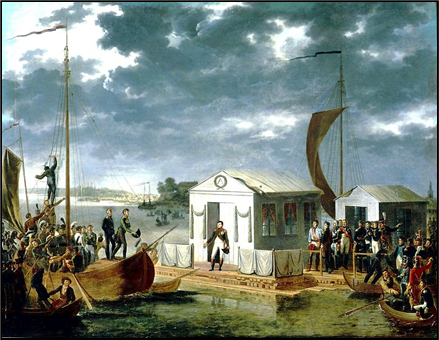 xxxxxIn many respects the extraordinary Treaty of Tilsit, signed in the East Prussian town of that name in July 1807, marked the height of Napoleon’s power, and this is hardly surprising. Following a meeting between him and Tsar Alexander - held on a specially constructed barge moored on the river Niemen (illustrated) - the two leaders hammered out a surprise settlement in which Russia joined with France in ruling jointly over Europe - Napoleon in the west, Alexander in the east! Russia agreed to the establishment of the Duchy of Warsaw and Kingdom of Westphalia - French satellites - , recognised the Confederation of the Rhine, and joined in the Continental System against Great Britain, coercing Denmark, Sweden and Portugal to do likewise. In return, France gave Russia a free hand in her dealings with Finland, Sweden and Turkey.
xxxxxIn many respects the extraordinary Treaty of Tilsit, signed in the East Prussian town of that name in July 1807, marked the height of Napoleon’s power, and this is hardly surprising. Following a meeting between him and Tsar Alexander - held on a specially constructed barge moored on the river Niemen (illustrated) - the two leaders hammered out a surprise settlement in which Russia joined with France in ruling jointly over Europe - Napoleon in the west, Alexander in the east! Russia agreed to the establishment of the Duchy of Warsaw and Kingdom of Westphalia - French satellites - , recognised the Confederation of the Rhine, and joined in the Continental System against Great Britain, coercing Denmark, Sweden and Portugal to do likewise. In return, France gave Russia a free hand in her dealings with Finland, Sweden and Turkey.
xxxxxThus Russia, despite its humiliating defeat on the battlefield, emerged from the Treaty of Tilsit with a political agreement which saved its face and, indeed, offered some political advantages. The same could certainly not be said for Prussia (in purple below). The proud nation which had been forged by Frederick the Great was reduced to almost half its size, forced to accept a French army of occupation, restricted as to the size of its own army, and obliged to pay a large indemnity.
The Treaty of Tilsit, signed in July 1807, was something of a surprise settlement. Following a meeting between Napoleon and the Tsar both agreed to rule jointly over Europe, France in the west and Russia in the East. The Tsar agreed to the setting up of the Duchy of Warsaw and the Kingdom of Westphalia, recognised the Confederation of the Rhine, and joined the Continental System against Britain. In return, France gave Russia a free hand in her dealings with Finland, Sweden and Turkey. In contrast, Prussia paid a heavy price at Tilsit. This proud nation was reduced by almost a half, forced to accept a French army of occupation, and obliged to pay a large indemnity. So severe were these conditions that over the next few years the Prussians, bent on revenge, completely overhauled their army. When it returned to the battlefield in 1813 it played a leading role in the final overthrow of Napoleon’s France.
G3c-1802-1820-G3c-1802-1820-G3c-1802-1820-G3c-1802-1820-G3c-1802-1820-G3c
xxxxx1807-1814 In 1807, by one means or another, Napoleon controlled practically all of Europe from the English Channel to the Russian border. But from now on his fortunes began to change. Many of the countries under his sway were anxious to regain their independence, and the Continental System was causing hardship to commerce and trade. In 1807 Portugal rejected these trade restrictions and Napoleon sent in an army of occupation. But this alienated the Spanish, particularly when he replaced their king with his brother, Joseph, and they rose in revolt. At the same time the British, taking advantage of this “Peninsular War”, sent an expeditionary force to Portugal in support of their fight for freedom. Then in 1812 Napoleon made his biggest mistake. To bring the Tsar to heel - also rejecting the Continental System - he invaded Russia with 500,000 men. He won the Battle of Borodino and reached Moscow but, unable to provide for his vast army - the Russians had laid waste the land - he had to begin the long retreat. Some 380,000 of his men perished from the cold, starvation or enemy action, and he lost the cream of his Grand Army. On his return he managed to ward off his enemies for a time, but in October 1813 he was roundly defeated by a large allied army at the Battle of the Nations, near Leipzig. He was exiled to the island of Elba, off the west coast of Italy and in September 1814 the Congress of Vienna assembled to reshape the map of Europe. But, in fact, it was not yet all over. In March 1815, Napoleon escaped from Elba and, rallying support, took on the Allies once again. As we shall see, it was to be for the last time.
1807-1814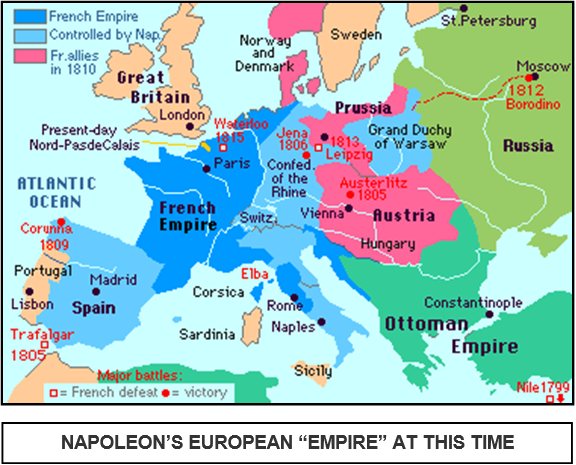
xxxxxThough he was to gain more territory in the coming years, by 1807 Napoleon ruled over a France which included Belgium and parts of Germany. In addition, he was king of Italy, Protector of the Confederation of the Rhine, and “Mediator” of the Swiss Confederation. Meanwhile, various members of his family governed territories on his behalf - including the kingdoms of Holland and Naples - and Austria and Prussia, humiliated by military defeat, posed no real threat. Thus by one means or another Napoleon’s France held sway over the whole of Europe from the English Channel to the Russian border, save for Portugal, Sweden, Sardinia and Sicily.
xxxxxBut Great Britain, immune from direct attack, remained a thorn in Napoleon’s side. The naval engagement at Trafalgar had confirmed British supremacy on the high seas, and it was for this reason, as we have seen, that in 1806 Napoleon resorted to the indirect approach - a Continental System designed to cripple Britain’s commerce and, at the very least, force the British government to come to terms. By mid-1807 every nation in Europe had put into effect a blockade of British goods and ships with the exception of one - Portugal. This defiance, motivated by economic necessity, was not to be tolerated. Napoleon sent an army over the Pyrenees and occupied the country. It was, it seemed, yet another French triumph. But the Continental System was a double-edged sword. It also brought economic distress to manufacturers and the labouring classes on the continent. Furthermore, in a number of countries there was growing discontent with the French. Nationalism was not the prerogative of the French people.
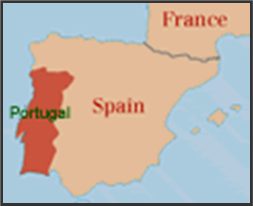 xxxxxAnd the seizure of Portugal brought about trouble on two fronts. Firstly, it required the occupation of Spain to ensure secure access. Secondly, it gave the British a toe-hold on the continent where they could make a very useful contribution to the land offensive against the French. In Spain, Napoleon’s dismissal of the Spanish king Charles IV, and his replacement by his own brother, Joseph, brought about a spontaneous uprising against the French, whilst in Portugal a British expeditionary force, having landed in August 1808, began the task of driving the French out of the country, and assisting the Spanish in their own bid for independence. The Peninsular War, as it came to be known, proved a serious drain on French resources in men and material, and weakened their armies in central Europe. Here they were faced with another patriotic rising, this time in Austria. They managed to defeat the Austrians at the Battle of Wagram in July 1809, and to seize more of their territory, but Napoleon’s marriage to the daughter of the Austrian king, Francis II, failed to gain the future support of that country.
xxxxxAnd the seizure of Portugal brought about trouble on two fronts. Firstly, it required the occupation of Spain to ensure secure access. Secondly, it gave the British a toe-hold on the continent where they could make a very useful contribution to the land offensive against the French. In Spain, Napoleon’s dismissal of the Spanish king Charles IV, and his replacement by his own brother, Joseph, brought about a spontaneous uprising against the French, whilst in Portugal a British expeditionary force, having landed in August 1808, began the task of driving the French out of the country, and assisting the Spanish in their own bid for independence. The Peninsular War, as it came to be known, proved a serious drain on French resources in men and material, and weakened their armies in central Europe. Here they were faced with another patriotic rising, this time in Austria. They managed to defeat the Austrians at the Battle of Wagram in July 1809, and to seize more of their territory, but Napoleon’s marriage to the daughter of the Austrian king, Francis II, failed to gain the future support of that country.
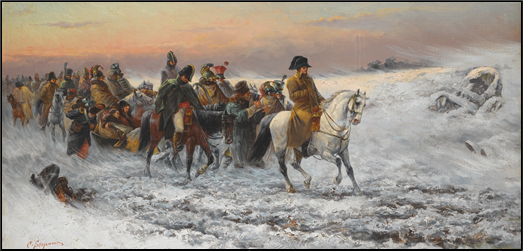 xxxxxThen in 1812 came the turning point in Napoleon’s career, his invasion of Russia. Prompted by a Russian refusal to enforce the Continental System, it proved a tragic error of judgement. He took his 500,000 strong army to Moscow, defeating the Russians at the Battle of Borodino en route, but he found the city and the surrounding countryside completely destroyed by fire. Deprived of winter quarters he began a retreat which cost the lives of 380,000 of his men, killed by the cold, starvation or enemy action. The following year a revitalised Prussia, joined by Russia, Britain and Sweden, opened the War of Liberation. At first Napoleon continued to hold his own, defeating the Prussians at Lutzen and Bautzen, and a combined force at the Battle of Dresden, but in October 1813 the Fifth Coalition dealt him a decisive blow at the Battle of Leipzig, known as the Battle of the Nations. It marked the end for Napoleon, or so it seemed. The following year allied forces flooded into France from the north, and Paris was taken in the March. Napoleon abdicated and was sent in exile to the island of Elba, just off the north-west coast of Italy, whilst in October the allied leaders assembled at the Congress of Vienna to restore the monarchies which Napoleon had overthrown across the width and breadth of Europe.
xxxxxThen in 1812 came the turning point in Napoleon’s career, his invasion of Russia. Prompted by a Russian refusal to enforce the Continental System, it proved a tragic error of judgement. He took his 500,000 strong army to Moscow, defeating the Russians at the Battle of Borodino en route, but he found the city and the surrounding countryside completely destroyed by fire. Deprived of winter quarters he began a retreat which cost the lives of 380,000 of his men, killed by the cold, starvation or enemy action. The following year a revitalised Prussia, joined by Russia, Britain and Sweden, opened the War of Liberation. At first Napoleon continued to hold his own, defeating the Prussians at Lutzen and Bautzen, and a combined force at the Battle of Dresden, but in October 1813 the Fifth Coalition dealt him a decisive blow at the Battle of Leipzig, known as the Battle of the Nations. It marked the end for Napoleon, or so it seemed. The following year allied forces flooded into France from the north, and Paris was taken in the March. Napoleon abdicated and was sent in exile to the island of Elba, just off the north-west coast of Italy, whilst in October the allied leaders assembled at the Congress of Vienna to restore the monarchies which Napoleon had overthrown across the width and breadth of Europe.
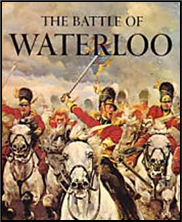 xxxxxBut as we shall see, their deliberations proved somewhat premature. In March 1815 Napoleon escaped from Elba - where he was ruler of the island! - and marched to Belgium, rallying support along the way. He won a victory over the allies at Ligny, but was defeated at Quatre-Bras and then in the June just failed to win the day at the close-run Battle of Waterloo, south of Brussels. This time he was exiled to an island way out in the middle of the Atlantic from which there was to be no return, and the Congress of Vienna was safely resumed. The Napoleonic Wars, which had criss-crossed Europe with devastating effect over the past twelve years, were finally at an end.
xxxxxBut as we shall see, their deliberations proved somewhat premature. In March 1815 Napoleon escaped from Elba - where he was ruler of the island! - and marched to Belgium, rallying support along the way. He won a victory over the allies at Ligny, but was defeated at Quatre-Bras and then in the June just failed to win the day at the close-run Battle of Waterloo, south of Brussels. This time he was exiled to an island way out in the middle of the Atlantic from which there was to be no return, and the Congress of Vienna was safely resumed. The Napoleonic Wars, which had criss-crossed Europe with devastating effect over the past twelve years, were finally at an end.
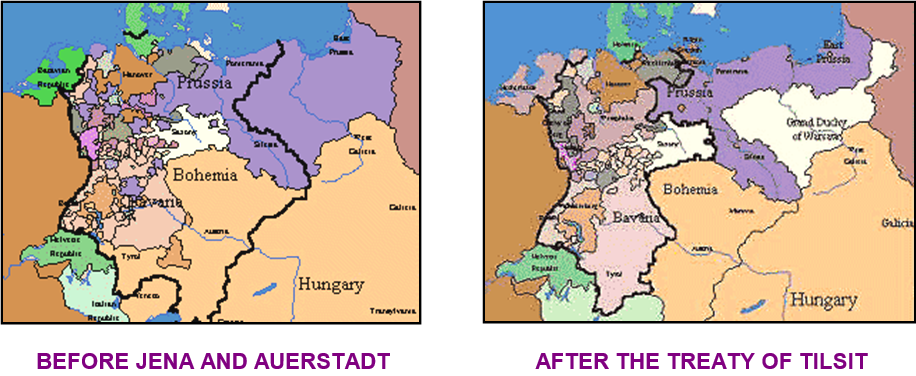
xxxxxCut down to a third-rate power, Prussia remained out of the war until 1813. Yet paradoxically there was a measure of consolation for the Prussians. So catastrophic had been their defeat that, over the next few years, they desperately set about to complete a thorough overhaul of their army. As a result, when it did return to the battlefield in 1813, it played a major part in the defeat of Napoleon and the subsequent liberation of Germany. As we shall see, at the Congress of Vienna which ended the war, the nation regained its prominent place in European history.
xxxxxIncidentally, the Treaty of Tilsit had repercussions in the Far East. Fearing that a French-Russian alliance would pose a threat to British India, attempts were made to win over the support of Afghanistan and Persia, and a treaty was agreed with the Punjab. In addition, attacks were mounted against French possessions, and these led to the capture of Java. It was from here, as we shall see, that an administrator of the East India Company, Thomas Stamford Raffles, was to establish a colony at Singapore, a small island off the southern tip of the Malayan Peninsular, in January 1819.
|
1807
|
February
|
The indecisive Battle of Eylau between the French and a Russo-Prussian army.
|
|
|
June
|
French gain decisive victory over the Russians at the Battle of Friedland.
|
|
|
July
|
The Treaty of Tilsit. Russia joins forces with the French, but Prussia is reduced by almost half, occupied by a French army, and obliged to pay a large indemnity.
|
|
|
November
|
French invade Portugal for trading with Britain. Royal family flees to Brazil.
|
|
1808
|
February
|
French forces occupy Rome.
|
|
|
March
|
French occupy Madrid and take over Spain.
|
|
|
June
|
Joseph Bonaparte, Napoleon’s brother, is made king of Spain.
|
|
|
August
|
British expeditionary force is sent to Portugal.
|
|
1809
|
January
|
British are defeated at the Battle of Corunna. General Moore is killed.
|
|
|
May
|
Wellington defeats French at the Battle of Oporto.
Napoleon annexes the Papal States. Pope Pius VII taken prisoner in July.
|
|
|
July
|
Austrians defeated at the Battle of Wagram.
|
|
1810
|
December
|
Napoleon annexes Holland and parts of northern Germany.
|
|
1811
|
May
|
The French abandon Portugal.
|
|
1812
|
June
|
Napoleon invades Russia after Tsar rejects the Continental System.
|
|
|
July
|
Wellington wins the Battle of Salamanca in Spain.
|
|
|
September
|
French win Battle of Borodino and occupy Moscow.
|
|
|
October
|
French retreat from Moscow begins. 380,000 men are lost en route.
|
|
1813
|
May
|
Napoleon defeats Prussian and Russian armies at the Battle of Lutzen.
|
|
|
June
|
Wellington wins the Battle of Vitoria and invades France.
|
|
|
October
|
Napoleon is defeated by Britain, Prussia, Russia, Austria and Sweden at the Battle of the Nations, Leipzig.
|
|
|
December
|
France is invaded by the Allies.
|
|
1814
|
April
|
Napoleon abdicates and is exiled to the island of Elba.
|
|
|
May
|
Louis XVIII enters Paris.
|
|
|
September
|
Congress of Vienna opens.
|
An Outline of the Napoleonic Wars 1807 to the Battle of the Nations, Leipzig 1813











 xxxxx
xxxxx xxxxx
xxxxx
 xxxxx
xxxxx xxxxx
xxxxx xxxxx
xxxxx